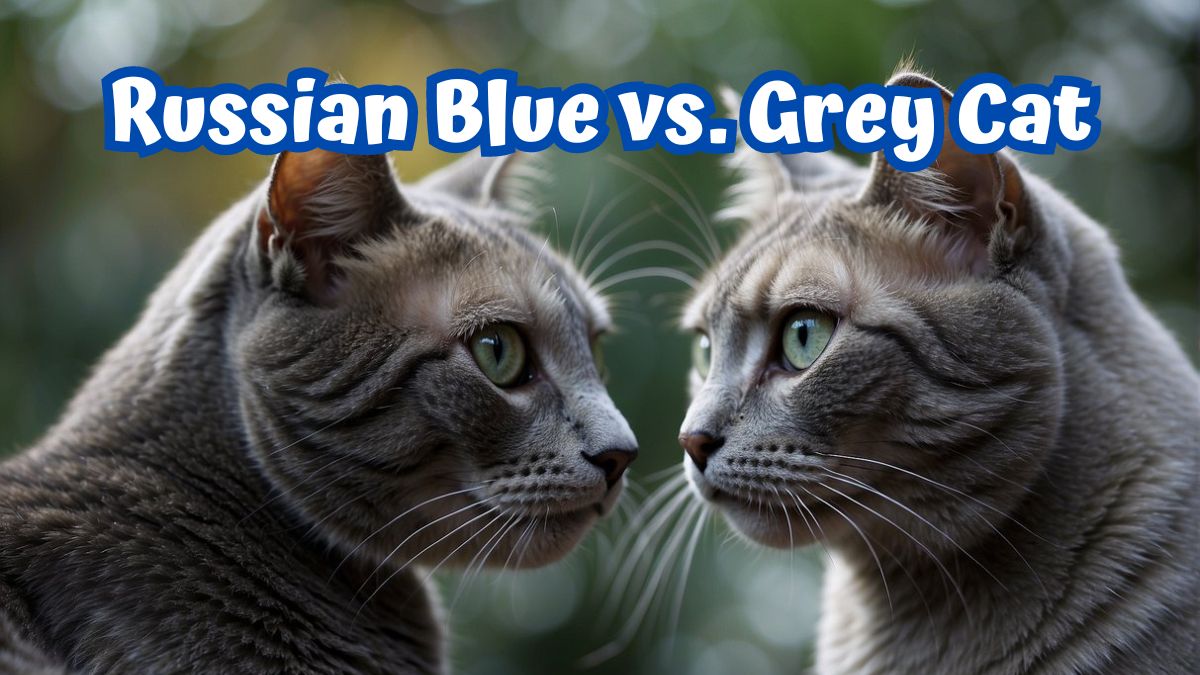The Russian Blue, with its unique blue-grey coat and bright green eyes, stands out from standard grey cats.
Originating in Russia, this breed features a plush double-layered coat on a slender frame, contrasting with grey cats’ varied shades and hair lengths, which aren’t limited to a single breed.
Grey cats also exhibit a more comprehensive range of eye colors and have more diverse lineage and characteristics.
The Russian Blue is known for its gentle and reserved demeanor, suited for quieter homes, while grey cats’ temperaments are more variable, ranging from active to laid-back.
Despite these differences, both can be affectionate and loyal pets, but potential owners need to consider the distinct qualities of each when choosing a feline companion.
Russian Blue vs. Grey Cat
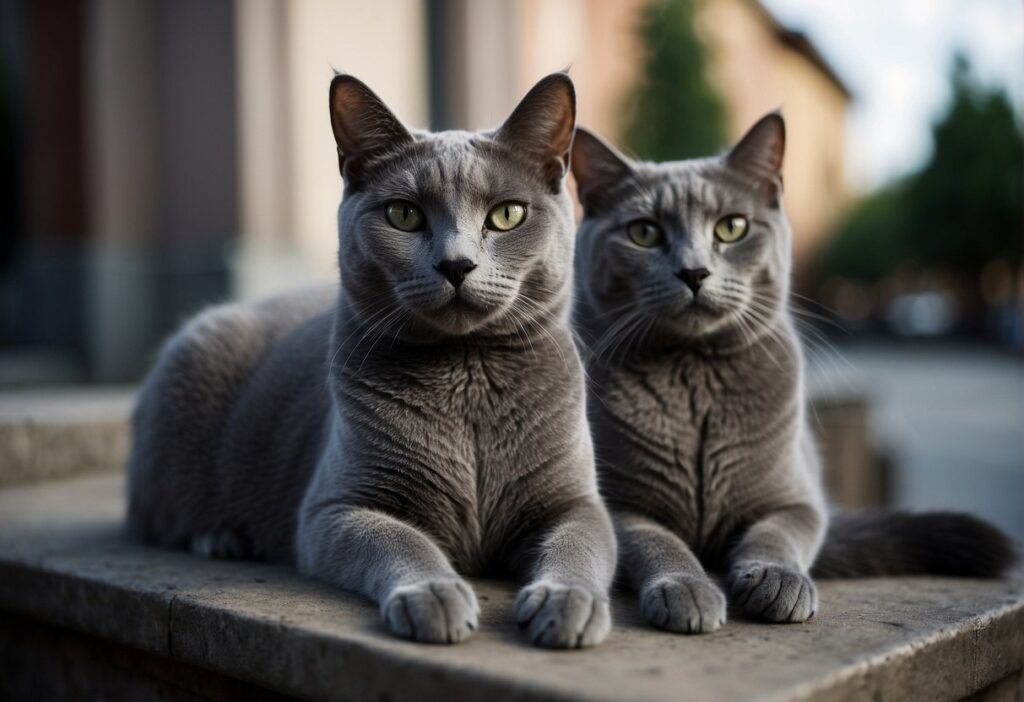
The history and origins of the Russian Blue and grey cat breeds reveal their unique pasts and the way they have been cherished for centuries.
Russian Blue Beginnings
The Russian Blue cat, a distinct natural breed, is said to have its roots in the northern Russian port city of Arkhangelsk on the Archangel Isles.
Believed to have been kept by Russian czars, this breed was first noted by outsiders in the 1860s when these blue-coated cats were brought to other parts of Europe, particularly Great Britain.
By the start of the 20th century, Russian Blues had made their way to the United States.
Grey Cats Through History
Grey cats, known for their solid grey or “blue” coats, have been present throughout history and can encompass a variety of domestic cat breeds.
These cats have been found across Northern Europe for centuries, often favored for their plush coats.
Grey cats were not distinctly classified until modern cat associations formed, such as the Cat Fancier’s Association (CFA), officially recognized the Russian Blue in 1949, following a pause in breeding activities during World War II.
Physical Characteristics
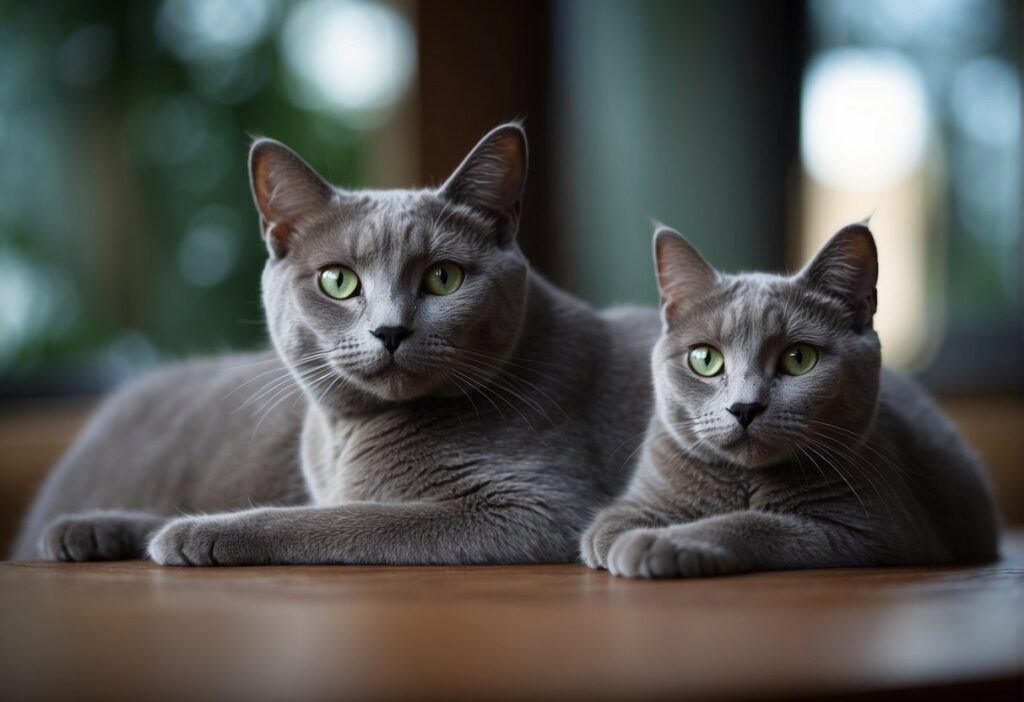
Russian Blues and grey cats display distinct physical features that contribute to their popularity and distinguish them from each other.
Anatomy of the Russian Blue
A sleek, medium-sized, slender, muscular body characterizes the Russian Blue cat.
Their coat is a distinctive blue-gray shade that is dense and fine with a plush, velvety texture.
Bright green eyes are perhaps the most striking feature of the Russian Blue, standing out against the uniform blue coat, which often has silver tips due to a unique light reflection.
This breed exhibits a distinctive elegance attributed to its slender body and refined head shape.
Typical Traits of Grey Cats
Grey cats, a broad category that includes various breeds, usually showcase a range of physical characteristics.
Their coats can be of varying shades of grey from light to dark, and the texture may differ significantly, ranging from thin to thick coats.
Unlike Russian Blue, grey cats may not have a uniform coat color and may display patterns or mixed hues.
While their eye color can vary, it is not tied to the coat color through a recessive gene as with the Russian Blue’s bright green eyes.
Depending on their specific breed lineage, grey cats may have rounded or angular features.
Personality and Temperament
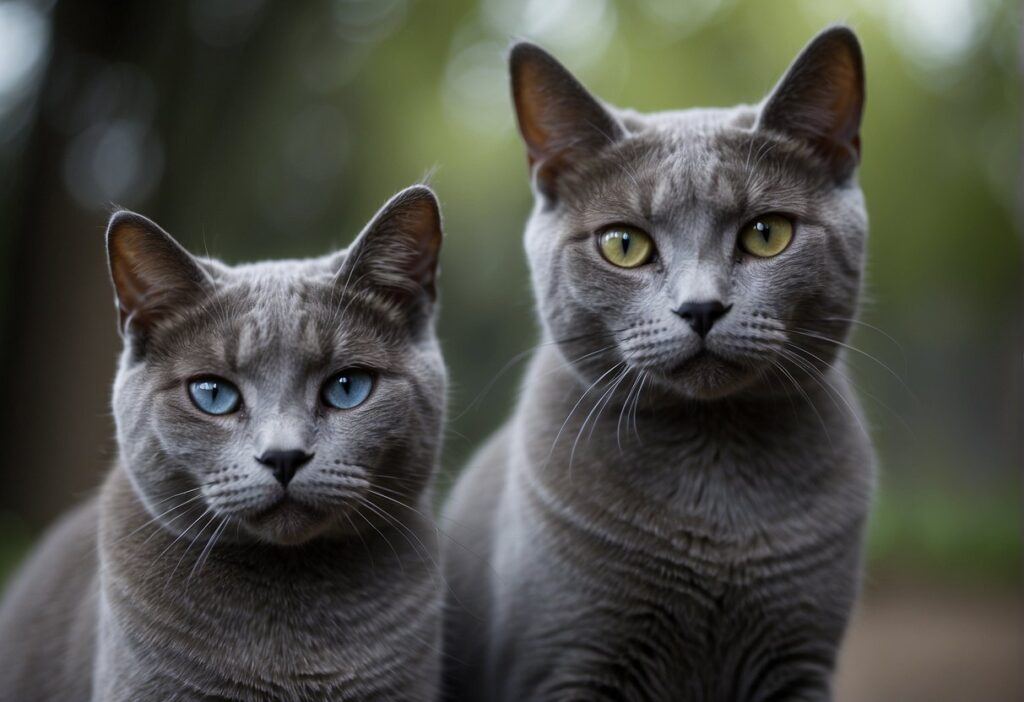
In the realm of domesticated cats, personality and temperament are essential aspects that can significantly influence a family’s decision when choosing a pet.
These factors often vary by breed and can impact how a cat integrates into a home environment.
Russian Blue Personality
The Russian Blue cat is known for its composed and gentle nature.
They are often described as intelligent and reserved cats but display a surprisingly affectionate side once comfortable with their family members.
- Intelligent: They require mental stimulation through interactive toys or games, which helps keep their sharp minds engaged.
- Loyal: Russian Blues tend to form strong bonds with their owners and follow them around the house.
Traits Common to Grey Cats
Grey cats, which can come from various breeds, are not defined by a single personality type.
Their temperament might range from the relaxed British Shorthair to the active Korat. However, some common traits are often observed in grey felines:
- Adaptability: Grey cats, on average, can adapt well to different family dynamics and living situations.
- ‘Good Luck Charm’: In some cultures, grey cats bring good luck to the home.
Health & Care of Russian Blue/Grey Cats
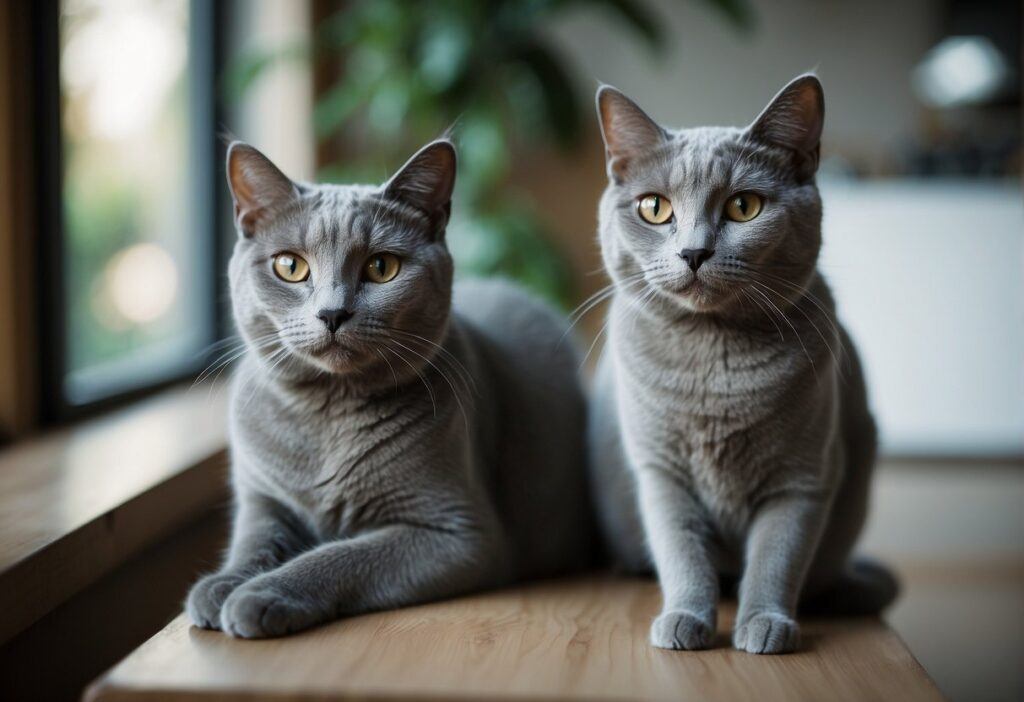
When considering the health and care of Russian Blues and grey cats, attention should be given to their specific needs and health concerns.
Proper care can ensure these felines lead a long and healthy life.
How to Care for Russian Blues
Russian Blues are known for their stunning blue-grey coats and bright green eyes.
Grooming is minimal due to their short, dense fur, which sheds less than many other breeds. They require only a weekly brushing to remove dead hair and distribute skin oils.
Russian Blues are considered low-maintenance pets. In terms of health issues, they are generally healthy but can be prone to polycystic kidney disease (PKD), a genetic condition.
Regular veterinary check-ups are essential for early detection and management.
Feeding a balanced diet and ensuring enough exercise are crucial in maintaining their health.
Interactive toys can provide mental stimulation to keep their intelligent minds active.
Daily/Weekly Exercise Regiment For Russian Blue Cats
| Time of Day | Activity | Description | Duration |
|---|---|---|---|
| Morning | Quiet Interactive Play | Engage with feather wands or soft toys on strings, catering to their gentle nature. | 15 minutes |
| Mealtime Enrichment | Serve breakfast in puzzle feeders designed for cats, stimulating their intelligence. | — | |
| Midday | Observation Time | Provide access to a window seat for quiet observation of outdoors, matching their contemplative nature. | 30 minutes |
| Independent Play | Offer toys that mimic prey, like small plush mice, for batting around independently. | 15 minutes | |
| Afternoon | Climbing and Exploration | Encourage exploration on a multi-level cat tree with treats or toys hidden at different levels. | 20 minutes |
| Mind Games | Engage in training or with intelligence toys, catering to their love of learning. | 10 minutes | |
| Evening | Grooming Session | Bond through grooming, benefiting their plush coat and allowing health checks. | 10 minutes |
| Evening Play | Engage in more vigorous play with toys that allow jumping or chasing to expend energy before bedtime. | 15 minutes | |
| Puzzle Feeder Dinner | Serve dinner in a different puzzle feeder from the morning to maintain interest and mental stimulation. | — | |
| Weekly | New Exploration Challenge | Introduce a new area or interactive toy once a week for exploration, supervised to ensure safety. | Once a week |
| DIY Toy Creation | Create a new toy from household items to keep engagement high with personal touch, introducing novelty. | Once a week |
Additional Tips
- Personal Interaction: Tailor the intensity of play and interaction to your Russian Blue’s mood, fostering a strong bond.
- Consistency: Maintain a routine, as Russian Blues value predictability.
- Safety: Regularly inspect toys and play areas for safety, ensuring a secure environment for your cat.
Maintaining Grey Cat Health
Grey cats, especially domestic shorthairs, often require primary health care, including routine vaccinations, parasite control, and annual check-ups to monitor for health changes.
Domestic shorthairs may not have the same genetic predispositions as purebred cats but can still encounter common feline health issues.
Grooming requirements are relatively simple; a weekly brushing is typically adequate to keep their short fur free of mats and to reduce shedding.
These cats need a well-balanced diet and regular exercise to prevent obesity, which can lead to other health problems.
Enriching their environment with toys and engagement can promote physical activity and reduce stress.
Breed Differentiation and Recognition
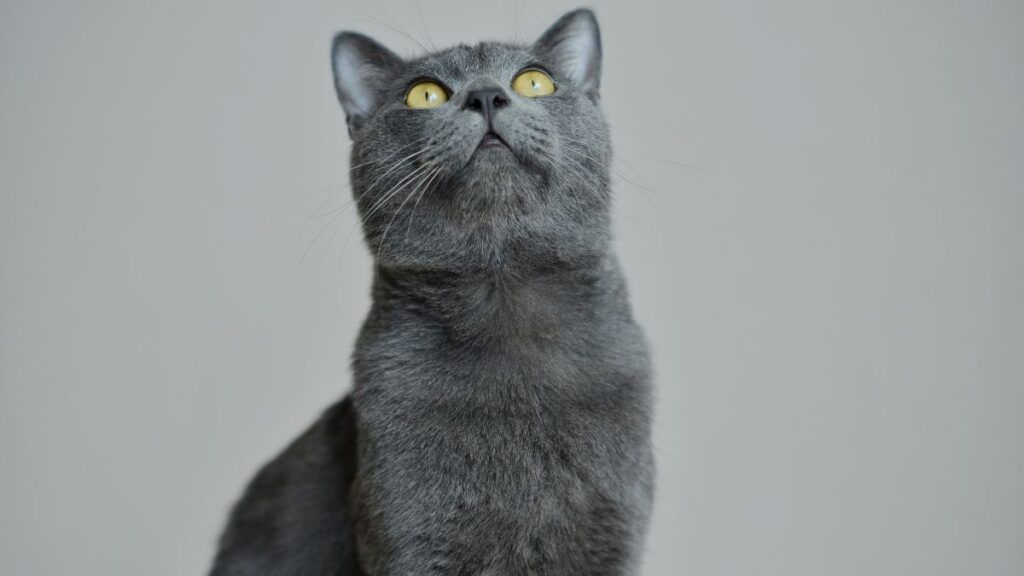
When distinguishing between the Russian Blue and various grey cats, it’s pivotal to note several key characteristics.
Due to a unique dilution gene, Russian Blue cats possess a distinctive silvery-grey coat. They are also purebred animals recognized by the Cat Fanciers’ Association.
Their coat is short, dense, and fine, with a plush texture.
In contrast, a domestic shorthair cat can display a similar grey color but lacks pedigree and the uniform coat texture and color found in Russian Blues.
The British Shorthair, sometimes called “British Blues,” may also exhibit a grey coat. However, they are stockier and have a broader face than the more elegantly built Russian Blue.
On the other hand, Chartreux cats have a robust build and a woolly blue-grey coat, while Korat cats showcase a silver-tipped blue coat. Yet both breeds have a heart-shaped face, unlike the Russian Blue.
Distinguishing features of Russian Blue kittens include bright green eyes, a bluish-grey coat, and a slender body.
While these traits may become more prominent as the kittens grow, they help differentiate from other cats with similar coats.
| Breed | Coat Texture | Body Type | Eye Color | Notable Features |
|---|---|---|---|---|
| Russian Blue | Plush, dense, fine | Slender, elegant | Bright green | Purebred, dilution gene |
| Domestic Shorthair | Varied | Varied | Varied | Non-pedigreed, diverse genetics |
| British Blue | Dense, plush | Stocky, broad | Copper or gold | Broad face, pedigree |
| Chartreux | Woolly | Robust | Gold or copper | Heart-shaped face, robust build |
| Korat | Fine, single coat | Muscular | Peridot green | Silver-tipped blue coat |
Distinctions extend beyond color and into lineage and breed history.
The British Shorthair and Siamese cats originate from England and Thailand, respectively, while the Russian Blue is believed to have been brought from the Archangel Isles in Russia.
The Oriental Shorthair is a product of breeding between Siamese and other breeds, thus boasting many potential coat colors, including grey shades, but not the same dense gray coat as the Russian Blue.
Related: Chartreux Cat vs. Russian Blue: Understanding the Differences
Living With a Russian Blue or Grey Cat
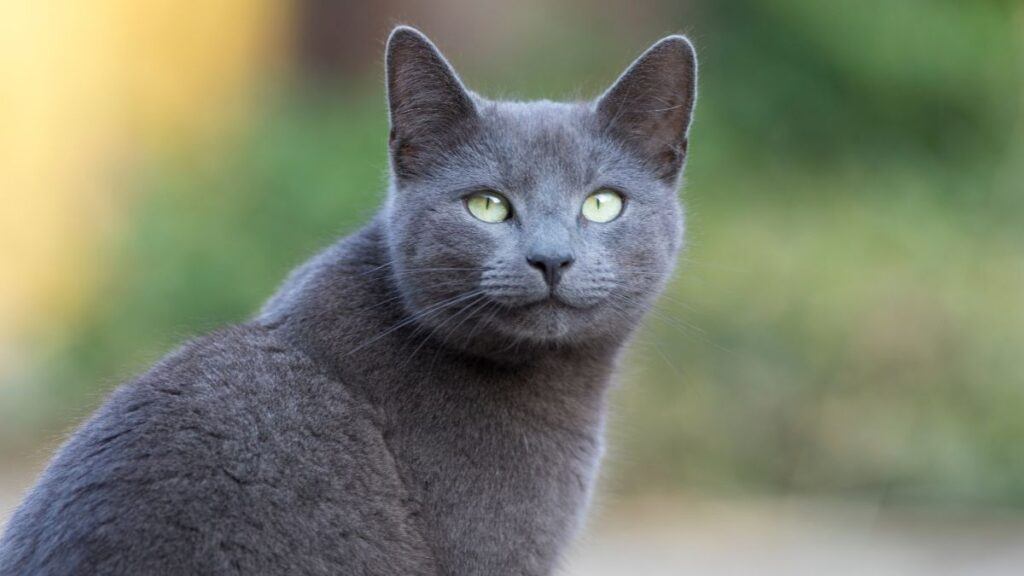
Choosing between a Russian Blue or a grey cat as a pet involves understanding their unique traits and lifestyles. Both can make excellent companions, but their care and integration into a household differ.
Integration Into Family Life
Russian Blues are known for their gentle and reserved temperament.
When introducing a new Russian Blue to the family, it’s essential to do so gradually, especially if other pets or young children are home.
To build trust, provide a quiet space to adjust and ensure they have slow, supervised interactions with family members.
Grey cats, a more general category, can have varying personalities. Some may be outgoing from the start, while others are initially shy.
New pets should be introduced to each family member individually. Pet parents should monitor their responses to new people and the front door area, as some cats may attempt to explore outdoors.
Caring for Your Cat’s Environment
Food and Nutrition
- Russian Blues: Require a balanced diet with measured portions to prevent obesity.
- Grey Cats: Diet depends on the breed or mix, but all cats benefit from high-quality cat food.
Litter and Hygiene
- Litter Boxes: At least one per cat, placed in a quiet location.
- Maintenance: Regular cleaning to encourage use and prevent odors.
Comfort and Play
- Beds: Soft, comfortable bedding in a draft-free location.
- Scratching Posts: Essential for claw health and to deter scratching on furniture.
Health and Longevity
Russian Blues often have a long lifespan; thus, maintaining their environment and health is key to a fulfilling life.
Regular veterinary checkups are vital for Russian Blues and grey cats, regardless of the breed, to ensure they remain healthy and thriving companions.
Introducing Cory Haasnoot, a devoted father, loving husband, and enthusiastic cat lover. As a key content creator for CatFurLife.com, Cory blends his family values and passion for felines into engaging and informative content. He brings a unique perspective to the site, sharing cat care tips and how cats can enrich family life and bring joy to households.

